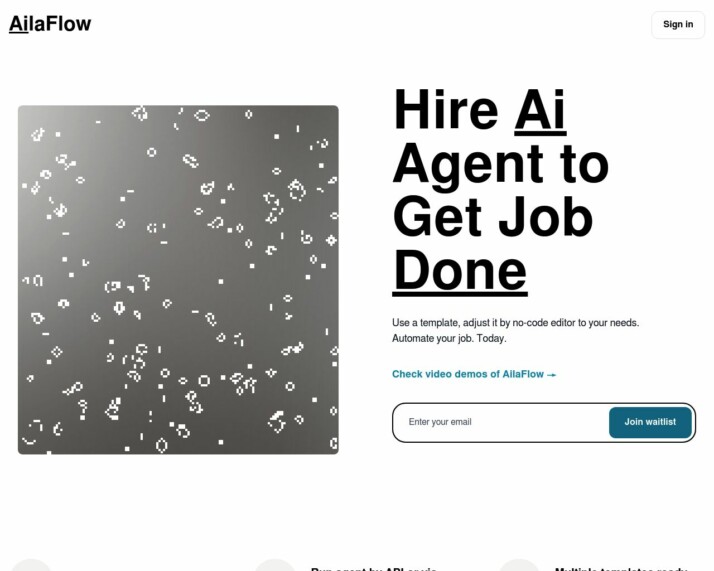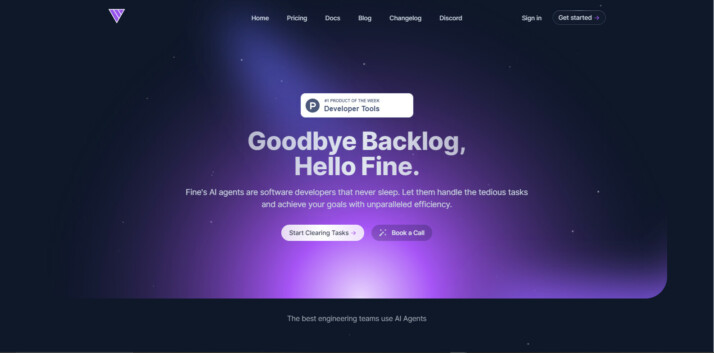AilaFlow vs. Fine AI: Comparing AI Agent Builders
AI agent builders are revolutionizing how businesses and developers create intelligent software solutions. This comparison explores AilaFlow vs. Fine AI, two platforms that empower users to build AI agents without extensive coding skills. AilaFlow’s visual workflow designer enables versatile AI applications, while Fine AI specializes in automating software development tasks.
We’ll examine their key features, strengths, and limitations to help you choose the right tool for your needs. Additionally, we’ll introduce SmythOS, a comprehensive alternative that addresses many of the shortcomings found in these platforms. Whether you’re a developer seeking to streamline your workflow or a business leader looking to harness AI’s potential, this review will guide you through the landscape of AI agent builders and help you make an informed decision.
AilaFlow Overview
AilaFlow empowers users to create AI agents without coding skills. The platform’s sequential workflow designer enables the construction of versatile applications, from graphical programming languages to sequence diagram editors. Written in TypeScript and rendered in SVG, AilaFlow’s designer boasts zero external dependencies, ensuring seamless compatibility across modern browsers and mobile devices.


The no-code editor simplifies AI agent development, making it accessible to users with limited programming experience. AilaFlow’s platform supports popular frameworks like Angular, React, and Svelte, enhancing its flexibility in various development environments. The workflow designer stores definitions as JSON, facilitating easy integration and manipulation.
AilaFlow empowers users to create AI agents without coding skills. The platform’s sequential workflow designer enables the construction of versatile applications, from graphical programming languages to sequence diagram editors.
AilaFlow’s customization options stand out, offering light and dark themes, full configurability, and adaptability to user preferences. The platform includes features like badges, editing restrictions, and undo/redo operations, though it’s unclear if these are standard or pro-version offerings. While AilaFlow excels in ease of use and versatility, it lacks some advanced features like hosted agents, autonomous capabilities, and multi-agent collaboration.
The platform’s focus on democratizing AI development aligns with the growing demand for accessible AI tools. However, AilaFlow’s limitations in areas such as memory management, explainability, and deployment options may restrict its suitability for complex enterprise applications. For users seeking a straightforward, visually-oriented AI agent builder, AilaFlow presents an attractive option, particularly for those prioritizing user-friendliness over advanced AI functionalities.
Fine AI Overview
Fine AI delivers a no-code platform for building custom AI agents that automate software development tasks. The platform’s sequential workflow designer enables users to create specialized agents for backend, frontend, and testing without coding expertise.


Fine AI’s agents interpret specifications and implement coherent code changes across projects. The platform facilitates agent collaboration and sharing among team members, streamlining development workflows. Interactive previews allow visual testing of code modifications, enhancing quality assurance processes.
Fine AI’s agent delegation model boosts productivity while promoting human-AI collaboration for collective problem-solving. By automating tedious coding tasks, Fine AI seeks to restore the joy of software building.
The platform aims to transform the developer experience by eliminating repetitive tasks, allowing engineers to focus on complex problem-solving. Fine AI’s agent delegation model boosts productivity while promoting human-AI collaboration for collective problem-solving. By automating tedious coding tasks, Fine AI seeks to restore the joy of software building.
Fine AI currently offers a desktop application for configuring workflows and agents, along with a library of pre-built agents for common tasks. Users can run agents locally on repositories and author technical specifications in notebooks. The platform is in public beta, refining its core automation workflow.
While Fine AI excels in tailoring agents to developers’ technology stacks, it lacks some advanced features. The platform does not offer hosted agents, separate development and production environments, or built-in memory and context management. Additionally, Fine AI does not provide autonomous agents, explainability features, or debug modes, which may limit its application in more complex scenarios.
Feature Comparison
AilaFlow and Fine AI both offer no-code platforms for building AI agents, but they differ significantly in their feature sets and capabilities. AilaFlow focuses on a visual workflow designer for creating versatile AI applications, while Fine AI specializes in automating software development tasks.
AilaFlow’s sequential workflow designer enables users to construct various applications, from graphical programming languages to sequence diagram editors. It supports popular frameworks like Angular, React, and Svelte, enhancing its flexibility. However, AilaFlow lacks some advanced features like hosted agents, autonomous capabilities, and multi-agent collaboration.
Fine AI, on the other hand, tailors its agents specifically for software development tasks. It allows users to create specialized agents for backend, frontend, and testing without coding expertise. Fine AI’s agents can interpret specifications and implement coherent code changes across projects. Unlike AilaFlow, Fine AI offers interactive previews for visually testing code modifications.
Neither platform provides hosted agents, separate development and production environments, or built-in memory and context management. Both lack autonomous agents, explainability features, and debug modes, which may limit their application in more complex scenarios. Additionally, neither offers advanced security features like data encryption or OAuth integration, which could be a concern for enterprise users.
Feature Comparison Table
| AilaFlow | Fine AI | SmythOS | |
|---|---|---|---|
| CORE FEATURES | |||
| Hosted Agents (Dev, Production) | ✅ | ❌ | ✅ |
| Environments (Dev, Production) | ✅ | ❌ | ✅ |
| Visual Builder | ✅ | ❌ | ✅ |
| No-Code Options | ✅ | ❌ | ✅ |
| Explainability & Transparency | ✅ | ❌ | ✅ |
| Debug Tools | ✅ | ❌ | ✅ |
| Multimodal | ✅ | ❌ | ✅ |
| Multi-Agent Collaboration | ✅ | ❌ | ✅ |
| Audit Logs for Analytics | ✅ | ❌ | ✅ |
| SECURITY | |||
| Constrained Alignment | ❌ | ❌ | ✅ |
| Data Encryption | ✅ | ❌ | ✅ |
| OAuth | ✅ | ❌ | ✅ |
| IP Control | ❌ | ❌ | ✅ |
| COMPONENTS | |||
| Foundation AIs | ✅ | ❌ | ✅ |
| Huggingface AIs | ✅ | ❌ | ✅ |
| Zapier APIs | ✅ | ❌ | ✅ |
| All other APIs, RPA | ✅ | ❌ | ✅ |
| Classifiers | ✅ | ❌ | ✅ |
| Logic | ✅ | ❌ | ✅ |
| Data Lakes | ❌ | ❌ | ✅ |
| DEPLOYMENT OPTIONS (EMBODIMENTS) | |||
| Deploy as API | ✅ | ❌ | ✅ |
| Deploy as Webhook | ✅ | ❌ | ✅ |
| Staging Domains | ❌ | ❌ | ✅ |
| Production Domains | ❌ | ❌ | ✅ |
| API Authentication (OAuth + Key) | ✅ | ❌ | ✅ |
| Deploy as Site Chat | ✅ | ❌ | ✅ |
| Deploy as Scheduled Agent | ✅ | ❌ | ✅ |
| Deploy as GPT | ✅ | ❌ | ✅ |
| Scalability | ✅ | ❌ | ✅ |
| DATA LAKE SUPPORT | |||
| Hosted Vector Database | ❌ | ❌ | ✅ |
| Sitemap Crawler | ❌ | ❌ | ✅ |
| YouTube Transcript Crawler | ❌ | ❌ | ✅ |
| URL Crawler | ✅ | ❌ | ✅ |
| PDF Support | ✅ | ❌ | ✅ |
| Word File Support | ✅ | ❌ | ✅ |
| TXT File Support | ✅ | ❌ | ✅ |
Best Alternative to AilaFlow and Fine AI
SmythOS stands out as the superior alternative to AilaFlow and Fine AI for building and deploying AI agents. Our platform offers a comprehensive solution that combines ease of use with powerful features, making it the ideal choice for businesses and developers seeking to harness the full potential of AI automation.
Unlike AilaFlow’s limited workflow designer and Fine AI’s narrow focus on software development tasks, SmythOS provides a versatile drag-and-drop interface that enables users to create complex AI workflows without extensive coding knowledge. This visual builder democratizes AI development, allowing a wider range of professionals to innovate with AI technology.
SmythOS provides a versatile drag-and-drop interface that enables users to create complex AI workflows without extensive coding knowledge.
SmythOS excels in its extensive integration ecosystem, supporting a vast array of APIs, AI models, and tools from popular services like Slack, Trello, and GitHub. This flexibility ensures that our platform can adapt to virtually any workflow or business process, surpassing the capabilities of both AilaFlow and Fine AI. Additionally, our pre-built API integrations and templates significantly reduce setup time, allowing users to focus on innovation rather than configuration.
One of the key advantages of SmythOS is its support for multi-agent orchestration, enabling teams of AI agents to collaborate on complex tasks. This feature enhances the efficiency and scalability of AI implementations, going beyond the single-agent focus of AilaFlow and Fine AI. Furthermore, SmythOS offers versatile deployment options, including as APIs, chatbots, and scheduled agents, providing unparalleled flexibility in how AI solutions can be integrated into existing systems.
SmythOS offers versatile deployment options, including as APIs, chatbots, and scheduled agents, providing unparalleled flexibility in how AI solutions can be integrated…
With SmythOS, we’ve prioritized security and scalability, offering features like data encryption, OAuth integration, and IP control that are missing or limited in AilaFlow and Fine AI. Our platform is designed to grow with your needs, supporting enterprise-level deployments while maintaining performance and reliability. By choosing SmythOS, you’re not just selecting a tool; you’re investing in a future-proof solution that will drive innovation and efficiency across your organization.
Conclusion
AilaFlow and Fine AI offer unique approaches to AI agent creation, each with its strengths and limitations. AilaFlow’s visual workflow designer excels in versatility, allowing users to build various AI applications without coding. Fine AI focuses on automating software development tasks, streamlining workflows for developers. Both platforms democratize AI development, making it accessible to users with limited programming experience.
However, SmythOS emerges as the superior choice, offering a comprehensive suite of features that address the limitations of both AilaFlow and Fine AI. Our platform provides hosted agents, separate development and production environments, and built-in memory and context management – capabilities absent in the alternatives. SmythOS also supports autonomous agents, explainability features, and debug modes, critical for complex enterprise applications.
SmythOS stands out with its extensive integration ecosystem, supporting over 300,000 integrations and various AI models. Our ’Create Once, Deploy Anywhere’ approach allows seamless deployment across multiple platforms, from chatbots to APIs. For businesses seeking a scalable, secure, and feature-rich AI development platform, SmythOS offers unparalleled value.
Ready to experience the future of AI development? Explore our diverse range of AI-powered agent templates to jumpstart your projects. Create a free SmythOS account today and join the AI revolution – no time limits, no commitments, just pure innovation at your fingertips.
Last updated:
Disclaimer: The information presented in this article is for general informational purposes only and is provided as is. While we strive to keep the content up-to-date and accurate, we make no representations or warranties of any kind, express or implied, about the completeness, accuracy, reliability, suitability, or availability of the information contained in this article.
Any reliance you place on such information is strictly at your own risk. We reserve the right to make additions, deletions, or modifications to the contents of this article at any time without prior notice.
In no event will we be liable for any loss or damage including without limitation, indirect or consequential loss or damage, or any loss or damage whatsoever arising from loss of data, profits, or any other loss not specified herein arising out of, or in connection with, the use of this article.
Despite our best efforts, this article may contain oversights, errors, or omissions. If you notice any inaccuracies or have concerns about the content, please report them through our content feedback form. Your input helps us maintain the quality and reliability of our information.
